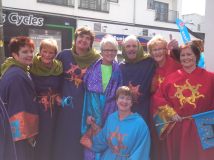Beautiful sweet Sligo success
As some 400,000 thousand of music lovers took to the streets of the Yeats City.


The best free traditional music show in the World as described by many, that is the Fleadh Cheoil na Eireann, as many thousand’s of music lovers packed the streets of Sligo all of last week.
Large parts of the city Centre was sectioned off as a big pedestrian only zone as many thousands of music lovers parked their cars up to three kilometres away from the town Centre and took bus rides in to the “Land of hearts desire City Centre Sligo to enjoy hundreds of sessions of traditional music and dance in dozens of pubs and at every street corner.
Two groups of young buskers at the all Ireland Fleadh in O’Connel Street, Sligo.
Buskers from all over Ireland and abroad aged from as young as eight years of age to eighty played and fiddled, whistled and tapped their bodhrans and boxes’ in the thronged parades and streets along the banks of the Garavogue River, which flows through the City Centre of the beautiful Yeats county of Sligo.
An estimated 30% of the 400,000 visitors to Sligo last week for the 63rd Fleadh Cheoil were from the overseas, mainly from Britain and America, but they also include dedicated Irish music lovers hailing from as far away as Australia, Japan, Korea, Spain and even Mexico.
The fleadh school, Scoil Eigse, which has been staging lectures and music classes, were also packed as they turned people away on some of the days last week.
Crowds were also turned away from a special fleadh film running at the Gaiety Cinema.
The Fleadh chairman Bartley Gavin said while the festival was attracting crowds since President Michael D Higgins opened it on last Sunday, The crowds were very big all week but the biggest crowds were on Thursday, Friday and Saturday.
The surge in visitors at the weekend was partly attributed to it being the opening day of the contests. Three days have been set aside for competitions this year, compared to two in previous years. They finished on Sunday night, there were many other events during the week, including a concert on the Peace 111 Gig Rig at Stephen Street car park on the final day Sunday where Dervish with lead singer Caty Jordon performed to a packed crowd there.
The curtain came down on this year’s successful Fleadh Cheoil Na Heireann 2014 in Sligo at 3pm on Sunday with a massive long colorful parade of choirs, Stilt walkers, an Orange order club from Northern Ireland, Macnas arts performers from Galway, and the Rathcormack, Drumcliffe choir performers who enacted the life of Colmkille on the opening day Sunday the 10th August, and many more entertaining happy groups from other areas of the Art’s.
 Pictured left some of the Rathcormack choir group who took part in the Colmkille Pageant on the opening day and in the final day parade through the City Streets of Sligo.
Pictured left some of the Rathcormack choir group who took part in the Colmkille Pageant on the opening day and in the final day parade through the City Streets of Sligo.
Bartley Gavin said early on the week that he would hope that many of the traditional musicians would stay over until about next Wednesday or Thursday, when the pubs have quietened down and they could enjoy each other’s music and make new friend’s, and this what exactly happened.
Mr. Gavin said: “That’s partly down to third places in many contests in the provincial finals going through this year. In the past it was always two.
He said the success of the Fleadh this year in Sligo was down to Sligo having played such an important part in our traditional musical heritage and the County it was fully recognised for that.”
Robert Naczas (38), from southern Poland, attracted lots of interest. When he was selling homemade two and three-string instruments made with hurleys, called da shtick guitars Robert, who has been in Ireland for eight years and lives in Sligo, plays harmonica in a group called the Out Of Towners.
The traditional music shop Manager/Owner in Castle Street said he was very happy with the shops trading performance at this year’s Fleadh,adding it was up there with the best.
The real success of the Fleadh in the Yeats county of Sligo this year was the amount of young people performing and playing our traditional music, some of them for the first time to thousands of people from Ireland and abroad. It was a wonderful example of Ireland’s greatest tradition “our music culture” being passed on to our Sons and Daughters, and them not being afraid to express their ways of playing our music and stamping their authority on our culture in a proud and emotional way.
The other success was the way the City and county was managed and shown in a new and proud way that the people of Sligo can work together with young, not so young, and the older experienced and wiser sectors of the community along with the Authorities pulling together to show Sligo what it has craved for many years, giving a true picture of what it is really all about, through co-operation at all levels,
A “Beautiful, Clean, Friendly and Delightful” City to behold not just for now but for ever more.
A “Beautiful, Clean, Friendly and Delightful” City to behold not just for now but for ever more.
Irish prisons struggling to tackle drug and staff problems
Use of methadone in Mountjoy criticised by prisons oversight group
The Methadone and Medication station in Mountjoy jail.
Prisons are still struggling to tackle drug and staffing problems, according to the latest round of prison visit reports released by the Department of Justice today.
One of the reports, which were compiled by prison visiting committees for various detention centres across the State, expressed severe reservations over the introduction of methadone into Mountjoy Prison’s low security Training Unit.
Committee members voiced concerns over the highly-addictive nature of the drug, which is used to wean addicts off opiates such as heroin, but acknowledged some successes of the fledgling system introduced earlier this summer.
Despite largely positive findings on conditions in Castlerea, Mountjoy, Wheatfield and Midlands prisons, the core issues of understaffing and drug use within jails provided particular points of concern for inspectors.
The report on Dublin’s Wheatfield Prison identified “a lot of [drug-related] difficulties” still ongoing in the facility, and also made reference to health issues such as a “vermin” problem caused by unsanitary methods of refuse disposal from prisoners’ cells.
It also detailed problems emanating from severely reduced library opening times within the 540 capacity prison, a situation which may detract from prisoners’ ongoing rehabilitation according to the Irish Penal Reform Trust (IPRT).
“While IPRT welcomes the improvements noted, particularly in Mountjoy Prison, we are concerned at recurring reports of limited access to libraries and workshops,” said IPRT executive director Deirdre Malone.
“It is essential that those aspects of prison life which support rehabilitation, including year-round access to education, training and libraries, must be fully resourced and accessible to all prisoners, including those on restricted regimes,” she added.
Minister for Justice and Equality Frances Fitzgerald said issues such as understaffing and drugs remain a top priority for the Irish Prison Service.
“The Irish Prison Service will continue to implement policies and procedures to reduce the availability and use of illicit drugs in the prison estate,” she said at the publication of the reports.
“Efforts are made on a continuous basis to prevent the flow of contraband into our prisons. Nevertheless the IPS recognises that constant improvements are required in this area,” she added.
Although offering a largely positive assessment of prisoners’ conditions amid ongoing refurbishments to Mountjoy’s D wing, the report on the unit stated that staffing arrangements had reverted back to 2012 levels of two prison officers for every 500 prisoners, a situation which had been described in a previous visiting committee publication as “unsatisfactory”.
It was also found that 30 prisoners had been confined to their cells for 20 hours a day in the State’s largest prison as of January 2014, with a further 10 locked up for periods of 19 hours per day.
The reports come during a busy period of activity for the IPS, with the release of two further reports – the inspector of prison’s annual report for 2013 and an 18-month overview on deaths in custody – expected imminently.
An investigation by the National Advisory Committee on Drugs and Alcohol in April found that 43 per cent of inmates who used heroin had started taking it in prison, while further visiting committee reports released at the beginning of May pointed to issues of severe overcrowding in Cork and Cloverhill prisons, describing some of the accommodation provided as “Dickensian”.
Cities of Ireland still littered but most towns getting cleaner
Irish business against Litter 2014
Areas of Dublin, Cork and Limerick occupy the six lowest positions in the table of 40 areas surveyed
Ireland’s towns continue to get cleaner but the main cities are still littered according to the latest survey by business group Irish business against Litter.
Areas of Dublin, Cork and Limerick occupy the six lowest positions in the table of 40 areas surveyed.
75% of towns and cities were found to be as clean as, or cleaner than European norms.
Kilkenny and Cavan were once again Ireland’s cleanest towns, followed by Killarney, Tramore and Longford.
They were among 18 towns deemed to be cleaner than the European average.
By contrast, Cork city, Limerick city, Dublin city, Tallaght, Dublin north inner city and Farranree in Cork were at the bottom of the table.
The survey shows a clear disparity between cities and towns.
IBAL puts this down to residents’ associations and tidy towns groups compensating for the scarcity of resources in local authorities in many towns, whereas these groups are often absent in cities.
The survey found that sweet papers were by far the most common form of litter, followed by cigarette butts, fast food wrappers and chewing gum.
A HEALTHY EATING REGIME CAN SAVE SIGHT


Diabetes Ireland, amongst other organisations to launch Eye Am What I Eat campaign.
Diabetic retinopathy is a common complication of diabetes and is the leading cause of blindness in working-age adults in Ireland. In fact, Irish statistics show that on average, one person with diabetes goes blind in Ireland each week. In the early stages, diabetic retinopathy will not affect the sight, but if the changes get worse, eventually the sight will be affected.
Symptoms of diabetic retinopathy can include blurred vision and black spots that appear to float in your eye.
According to eye doctor Mark Cahill, spokesperson for the Irish College of Ophthalmologists at the Royal Victoria Eye and Ear Hospital, “If diabetic retinopathy is not detected in the early stages it can lead to vision impairment and even vision loss.
“Eating well and maintaining a healthy lifestyle are hugely important but it is also essential for anyone with diabetes to have their eyes screened annually in order to detect the signs of diabetic retinopathy as early as possible.”
Sinead Hanley, Senior Dietitian at Diabetes Ireland, explains “Following a healthy lifestyle by taking regular physical activity and achieving a healthy weight through a balanced diet is the key to managing your diabetes and maintaining healthy eyes.”
The National Diabetic Retinal Screening Programme, ‘Diabetic RetinaScreen’ offers free, regular diabetic retinopathy screening to all people with diabetes, aged 12 and older.
Through the programme, people who are registered are invited to attend for screening. When people get the letter of invitation, they need to call the Freephone number listed on their letter to make an appointment. This will go a long way to maintaining healthy eyes and preventing vision loss in people with diabetes.
What are these Chimps saying? some 10 Hours of ‘chimp chat’ maybe
Dutch academics want to encourage research into what animals say in recordings
Ten full hours of “chimp chat” have been put up online in order to encourage more research into what the animals are saying.
Ten full hours of ‘chimp chat’ have been put up online in order to encourage more research into what the animals are saying.
This valuable resource was originally recorded the early 1970s in Tanzania, but has now been digitised and made available to help the study of chimpanzee communications.
It ranks as the largest dataset of recordings from free-living immature chimps yet collected, and includes the whole gamut of their vocalisations including grunts, hoocalls, barks and squeals.
Details of their recording are published this afternoon in the journal Scientific Data. They were collected by Dutch researchers the late Hetty van de Rijt-Plooij, and Frans Plooij at Gombe National Park, Tanzania from 1971 to 1973.
None of the recordings have been analysed for any meaning behind the hours of adolescent chimp chatter, so they could represent an important opportunity to learn whether the sounds have any real meaning, the journal suggests.
The great apes including chimps are our closest living relations. We share about 95 per cent of our DNA with chimps so it may be that there is hidden content in the sounds.
There is already extensive research into great ape vocalisations because of this and the journal points to this work. Recent studies have found there are similarities between human and chimp language including having regional dialects.
The digitised recordings are stored in the Macaulay Library at Cornell University and released via the Dryad Repositoryonline.
The release also incudes the original notes on the contexts of the calls, now translated from the original Dutch into English.







No comments:
Post a Comment